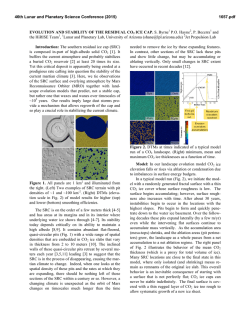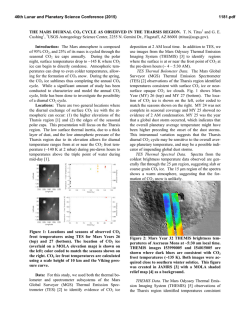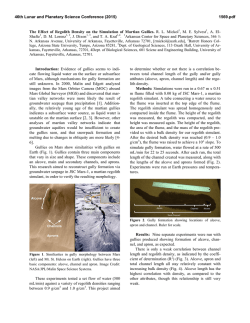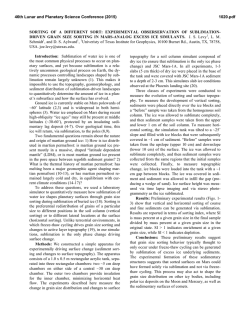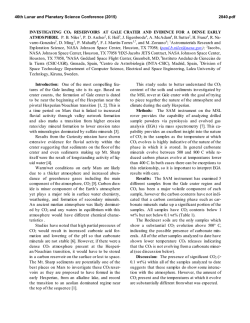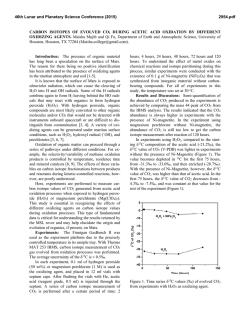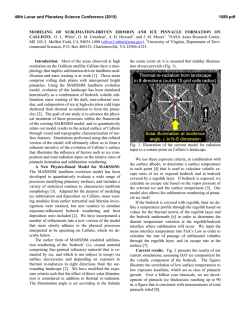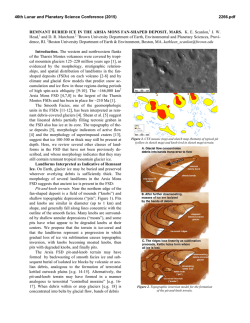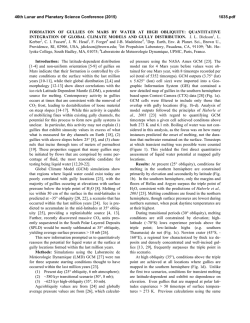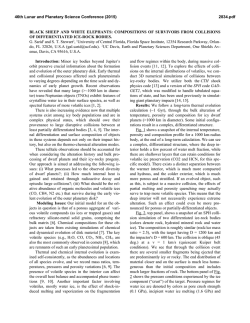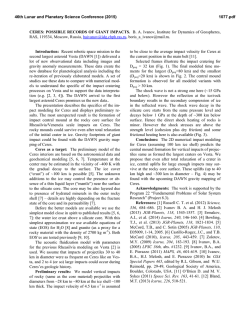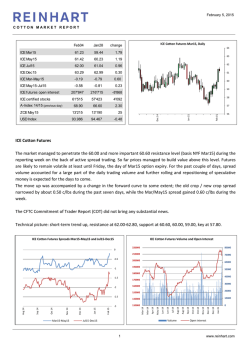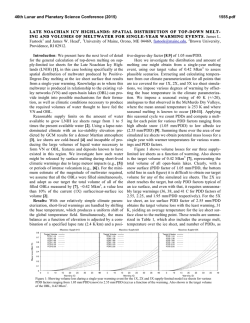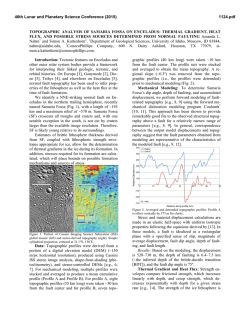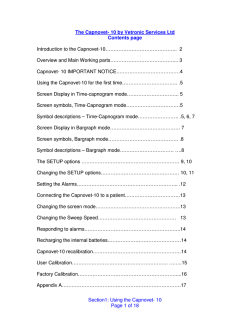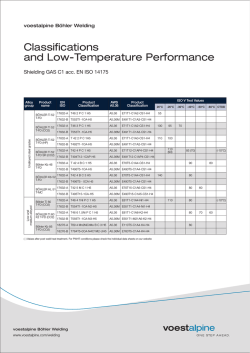
documento 479321
46th Lunar and Planetary Science Conference (2015) 2471.pdf CO2 DRIVEN FORMATION OF GULLIES ON MARS. C. Pilorget1,2 and F. Forget3 1 Division of Geological and Planetary Sciences Caltech, Pasadena, CA. 2IAS, batiment 121, 91405 Orsay Campus, France, 3(Presenting author) Laboratoire de Météorologie Dynamique, IPSL, Paris, France ([email protected]) Introduction and summary: Since their discovery by MOC [1], Martian Gully landforms have attracted considerable attention because they resemble terrestrial debris flows formed by the action of liquid water [1-5]. They have thus been argued to be evidence for relatively recent liquid-water habitat on Mars. This interpretation is now questioned by the discovery of ongoing gully formation occurring in conditions much too cold for liquid water, but with seasonal CO2 frost present and defrosting [6-10]. However, how a relatively thin seasonal dry ice cover could trigger the formation of decameter large debris flows exhibiting levees and sinuosities as if they were liquid-rich remained mysterious Using a thermo-physical model of the Martian soil, we show that, during the defrosting season, the pores below the ice layer can be filled with CO2 ice, and subject to extreme pressure variations. The subsequent gas fluxes destabilize the soil and create gas-lubricated debris flows with the observed geomorphological characteristics of the Martian gullies. Moreover, such subsurface activities are precisely predicted at latitudes and slope orientations where gullies are observed. This shows that Martian gullies result from geological dry ice processes with no earthly analogs. Previous Scenarios for the formation of gullies: By analogy with the Earth, the formation of gullies have been assumed to result from the melting of water ice (possibly a few hundreds of thousand years ago when the obliquity was higher [4]) or by episodic groundwater release [1,5]. However, these scenarios have recently been questioned by the observations of gully formation occuring during the period when seasonal CO2 frost is present and defrosting, pointing to a role of the CO2 condensation-sublimation cycle [6-10]. The actual processes at work, however, have remained enigmatic. A few theoretical studies had previously suggested that seasonal CO2 ice activity could play a role in the formation of gullies [11-13]. However these models had difficulty explaining how thin seasonal dry ice deposited above the regolith could trigger the formation of decameter-scale debris flows behaving as if they were lubricated by a liquid [12] unless eolian sediments were put over the CO2 ice sheet by seasonal processes [13] but then the amount of material is much too low to explain the observed morphology of the gullies [14]. Numerical model. We have developed a model able to compute the seasonal evolution of a column composed of an underlying regolith, a CO2 ice layer, and the atmosphere above [16, 15]. Below the surface, in the CO2 ice layer (when present) and in the regolith, the model simultaneously solves the heat conduction and the radiative transfer through the ice [16] as well as the diffusion, condensation and sublimation of CO2 and the related latent heat exchanges. A characteristic of the locations where CO2 ice is predicted to condense (latitude >50° on flat surface and down to ~30° latitude on pole-facing slope) is that a subsurface water ice table in equilibrium with the atmospheric water vapor is always expected to be present below a dry material layer of several centimeters to a few tens of centimeters [17]. We modeled the regolith accordingly, with a dry porous layer above an impermeable, ice-cemented, high thermal inertia soil. A scenario for the formation of gullies with CO2 ice. Simulations were first performed to model the Russell crater megadune (54.5°S, 12.7°E), one of the key locations where recent gully formation has been observed [7,9,18-20]. While CO2 condenses on the surface in late fall, it is observed that the albedo remains low [18], suggesting that the solid CO2 forms a translucent slab of ice. In the model, as the daytime solar light penetrates into the CO2 ice slab and heats the underlying regolith, the temperature at the base of the CO2 ice slab increases. Some CO2 sublimes and diffuses down to keep the porous layer sandwiched between the CO2 ice and the impermeable permafrost in vapor pressure equilibrium with the CO2 ice slab (Fig.1 and 2). The gas is trapped and the pressure can rise significanly. Figure 1: the sequence of events leading to the formation of CO2-regolith viscous flows At the end of winter, the thickness of the CO2 ice layer reaches 30 cm while the solar flux at midday increases. Around Ls=149°, the temperature in the regolith substrate increases from 153 K in the morning up to about 158 K in the afternoon. Accordingly the pressure rises daily from 1200 to 2300 Pa, well above the atmospheric pressure at 590 Pa. Two interesting 46th Lunar and Planetary Science Conference (2015) phenomena then occur during daytime. First, the temperature within the regolith tends to be lower than at the top of the regolith where the solar flux is absorbed. As a consequence, CO2 condenses in the coldest pores of the soil a few centimeters below the CO2 ice slab base. Second, the pressure below the ice can overcome the cryostatic pressure exerted by the CO2 ice layer and lift it. Eventually the slab should rupture to form jets of CO2 gas [21] potentially carrying some regolith material with it. The pressure within the pores then drops down to the atmospheric pressure, leading to a much lower condensation temperature than prior to the ejection (Tcond ~148 K). The CO2 ice that is present within the pores and at the base of the slab sublimes rapidly. Figure 2: Evolution of the CO2 gas pressure and total amount of CO2 (pressurized gas and ice, converted to a volume at atmospheric pressure) in the porous soil below the seasonal CO2 ice sheet simulated on the Russell crater megadune over an 8 sol period in late southern winter, at the time of the first CO2 gas ejections and ice layer ruptures. This illustrates the large amount of gas in excess that must flow through the soil porous medium and which can destabilize and fluidize the subsequent debris flow. When occurring on slopes, this process is likely to destabilize large amount of soil material. The volume of gas that has to flow up through the soil pores is considerable because it combines the depressurized excess gas (up to 1 m3 per m2 in our example) with the gas produced by the sublimation of the CO2 ice present within the regolith and which becomes suddenly unstable (up to 3 m3 per m2). Furthermore, a large part of the gas will flow laterally through the porous medium to reach the location of the vent in the slab. While this process has no exact analog on Earth, it can be related to terrestrial pyroclastic flows, which are gas-particle mixtures generated during volcanic eruptions. A wide range of pyroclastic flows exists, depending on the proportion of gases, and our case can 2471.pdf be compared to the denser ones dominated by particle friction [22]. These have been found to exhibit levees [22] which are very similar in size to the ones observed on Mars [2]. More generally, the study of pyroclastic flows as well as the industrial applications of gas-fluidized grains has led to many laboratory experiments and theoretical studies [22-24] which show that granular material can be fluidized by an upward gas flux and that they create debris flows behaving like liquid-fluidized flows. The viscosity of typical flows in our simulations can be estimated to range from a few tens to a few thousands of Pa.s. Such values are similar to water triggered debris flows and consistent with previous calculations on Martian gullies [2,20,25]. Importantly, these gas fluidized debris flows can occur below the theoretical angle of repose [23], which has been a concern in the understanding of gully landforms formation [2]. In our simulation the CO2-induced destabilization of the soil can repeat multiple times throughout the defrosting season, and even increase in intensity after the first ejection. Spatial distribution of gullies. We performed model calculations for a wide range of latitudes and slope orientations. These simulations show that highpressure CO2 gas trapping in the subsurface and the subsequent formation of ice is predicted where gullies are observed, and not elsewhere, in particular on pole facing slopes between 30° and 45° latitude, and with no orientation preference above 45° latitude [3,4]. References: [1] Malin et al. Science 288, 23302335 (2000) [2] Mangold et al. JGR 108, 5027 (2003). [3] Balme et al. JGR 111, E05001 (2006). [4] Costard et al. Science 295, 110-113 (2002) [5] Mellon and Phillips JGR. 106, 23165-23180 (2001) [6] Dundas et al. GRL 37, L07202 (2010) [7] Reiss et al. GRL 37, L06203 (2010) [8] Hansen et al., Science 331, 575(2011) [9] Dundas et al. Icarus 220, 124-143 (2012). [10] Dundas et al. Icarus in press (2014). [11] Hoffman, Astrobiology 2, 313-323 (2002). [12] Stewart and Nimmo, JGR 107, 5069 (2002) [13] Cedillo-Flores. GRL 38, L21202 (2011) [14] Pilorget et al. JGR 118, 2520-2536 (2013) [15] Forget, et al. JGR 104, 2415524176 (1999) [16] Pilorget et al. Icarus 213, 131-149 (2011) [17] Aharonson and Schorghofer JGR. 111, E11007 (2006). [18] Reiss et al. GRL 30, 1321 (2003). [19] Gardin et al. JGR 115, E06016, (2010) [20] Jouannic et al. Plan. Space Sci. 71, 38-54 (2012) [21] Kieffer et al. Nature 442, 793-796 (2006) [22] Félix and Thomas EPSL 221, 197-213 (2004) [23] Ishida et al. Powder technology 27, 7-12 (1980) [24] Schügerl, In: Fluidization, Academic Press. London, 261-292 (1971) [25] Mangold et al., JGR. 115, E11001 (2010). [26] Thomas et al. Icarus 205, 296-310 (2010)
© Copyright 2025

